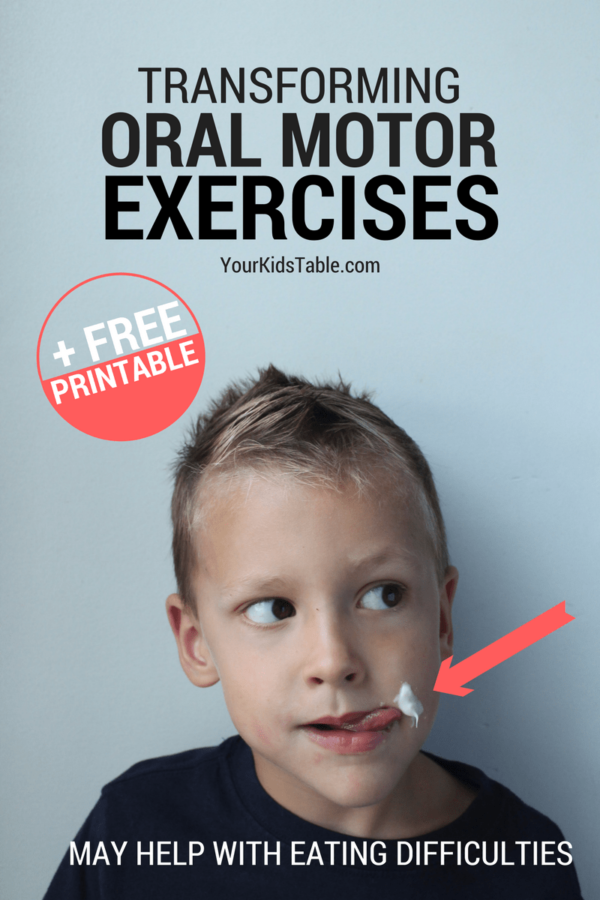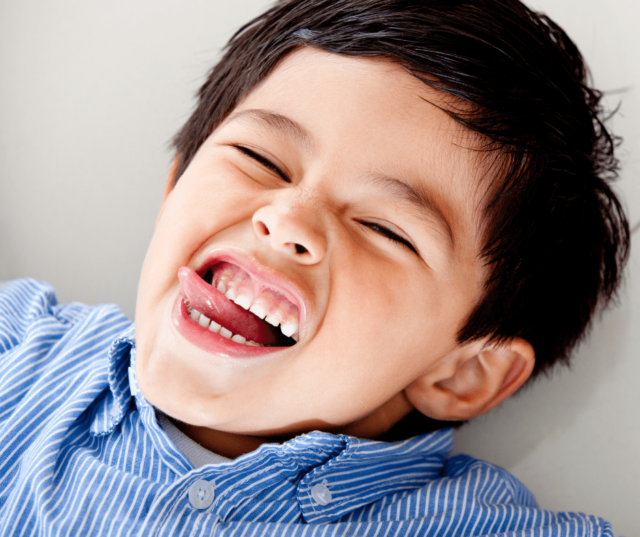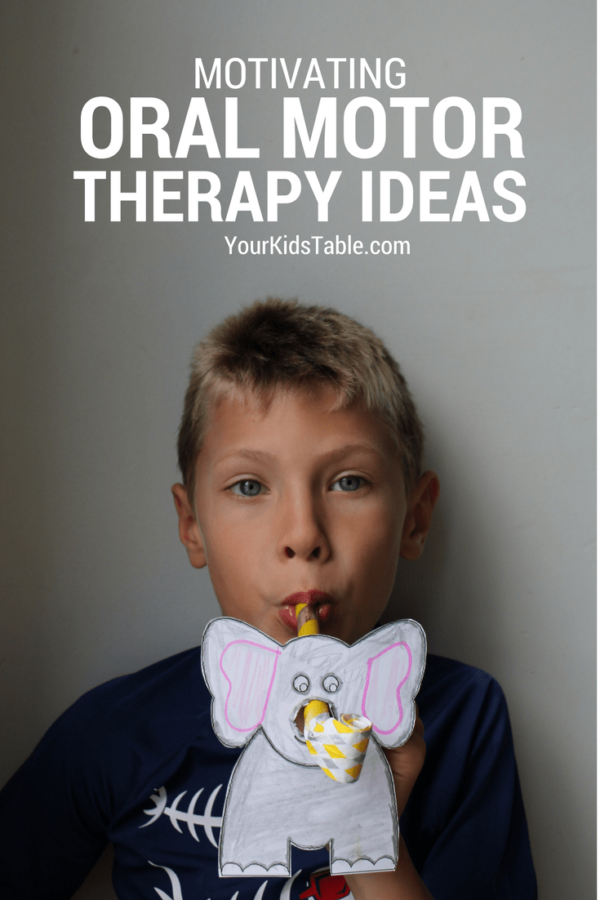Tons of oral motor exercises for toddlers and kids that can easily and naturally be used in the home. Plus, get a free downloadable PDF!
I’m getting a little bit technical in this post, as I tell you about the powerful, but often unheard of, oral motor exercises. Unless you happen to have a child in feeding or speech therapy, then you’ve probably not heard the term before. It’s very common lingo in both occupational and speech therapy. I’m taking the time to talk about oral motor exercises because using them can absolutely transform how your child eats, if they won’t eat a variety of foods or if your baby/toddler is having a hard time transitioning to table foods.
The problem is that oral motor exercises don’t help in every instance of extreme picky eating or babies that won’t eat. To know if they’re going to be helpful for your child, we’ll need to do some detective work. To begin with, you’ll need to think about what and how your child eats. I think an example might help here, so I’m going to tell you about a little boy, Micheal, that was having difficulty eating. He was 12 months old when his mother came to me for help.
Micheal’s mother desperately told me that he wouldn’t eat foods. Then, she corrected herself, and said, “Well, he tries to eat some foods, but all of the food comes right back out of his mouth.” Aha, it’s an important clue that Micheal was trying to eat and not just flat out refusing (we’ll get to why in a minute). I learned that Micheal was taking all sorts of soft cooked veggies and fruits, putting them into his mouth, seemingly chewing them for a long time, and then they would haphazardly fall out of his mouth.
Micheal would also accept some pureed foods and had done okay eating baby foods, but mostly seemed indifferent to the whole experience.
His mother was stressed.
Confused.
In Micheal’s case, oral motor exercises were a perfect strategy to help him learn to eat better! And, they helped a lot, combined with other strategies for helping babies learn to eat finger foods. Within a few weeks, Micheal was eating 5-7 new foods, and they weren’t falling out of his mouth! (Read more about how to transition baby and toddlers to table foods.)
If Micheal hadn’t received some additional help with his oral motor skills, he might have continued to struggle to eat. His family would have done their best, guessing what to do at each turn. He may have grown into a 1, 2, 3 year old, or older with serious picky eating challenges. At some point, his oral motor skills likely would’ve gotten at least a little better, but many other layers would’ve been added to the picky eating problem, making it hard to unravel.
What could’ve happened is a story I see in front of me all the time.
Of course, Micheal’s story is just one example of how helpful oral motor exercises can be, and they certainly aren’t just for babies or toddlers. Children of all ages may benefit from them.
Before we begin, keep a look out for the Feeding Therapy and oral motor exercises downloadable PDF at the end of the post and you’ll get a bonus: Food Diary Log.
What Does Oral Motor Mean Exactly?
Oral motor refers to how we use the muscles inside of our mouth. This includes the tongue, lips, cheeks, and jaw. They are all parts of our mouth and are tied to tons of muscles, and just like any muscle, it can be strong or weak. Coordinated or not coordinated.
We need our oral motor skills to be able to talk, eat, or drink from a straw. They aren’t something most of us give much thought to, but they are very important.
Signs a Child May Need Oral Motor Exercises
This is where we’ll start our detective work! Below, I’m going to list common signs you might see if your child has either some difficulty coordinating their oral motor skills or underlying weakness. It’s important to note that you’re looking for several signs to be present to point towards your child benefiting from oral motor exercises.
Also, this is not any sort of diagnosis. If you’re concerned about your child’s oral motor skills, I’d highly recommend a feeding therapy evaluation or if your child is under three and you live in the U.S., you may qualify for a free in-home evaluation from your state’s early intervention program.
For the feeding therapists, OT’s, or SLPs, that have to assess feeding, you know it can be hard to find a good screening tool. If that’s the case for you check out The Picky Eating Hierarchy: Screening Tool to Identify Feeding Difficulties and Treatment Plan in our shop.
Here are some red flags that oral motor skills needs some attention:
-
- Food falling out of mouth while trying to eat
- Difficulty chewing
- Mashes food with tongue
- Sucks on food instead of chewing
- Will hold food in mouth, sometimes for hours (often referred to as “pocketing food“, there are other reasons children do this, as well)
- Gagging on food after it’s been in mouth (not immediately or at the sight of food, check out this guide on baby gagging)
- Mouth is often in an open position
- Tongue hangs out of mouth
- Difficulty sticking tongue out
- Never chewed on toys or teethers as a baby
- Difficulty learning to eat table and finger foods as a baby and toddler
- Preference for certain texture of food (Crunchy or soft)
- Difficulty drinking from a straw (if over 24 months old)
- Drooling (only consider when combined with other factors on this list, as drooling has many different potential causes. Learn more about when your child is too old to drool here)
How to Use Oral Motor Exercises with Kids
If your child is in feeding or speech therapy, you may see their therapist practice oral motor exercises for a certain amount of repetitions or over a period of time. And, if you’ve been told to follow through on that at home, then please follow the direction of your therapist first.
For many toddlers though, it’s nearly impossible to get them to sit and complete “exercises”. And, for older children, it may start to feel like a chore. If it does, they likely aren’t going to try very hard or they’re going to rush to get through them, not really reaping the full benefit. That’s why I like to use oral motor activities in their play as much as possible.
This is actually pretty easy to do. Once you learn about what the oral motor exercises are below, you can either make a list (or print mine out), gather any simple supplies you might need, and have them on the ready. You may decide to have a basket of these items out for your child to engage with at any time, or maybe to set up a time everyday that you play with the oral motor toys.
I don’t like to call it “exercise” time, unless I have to. Ideally, I like to just use oral motor exercises as part of a routine. For instance, I might find some time I can focus on them after breakfast each day for 10 minutes, where I get down on the floor and be silly with the ideas and toys below. Or, I might try if I had a 15 minute commute after daycare or school (most of the exercises can be done easily in the car). Giving your child the chance to do oral motor exercise everyday or a couple times a week can have a big impact.
Doing these activities with your child and demonstrating is very important, too! Kids that need oral motor exercise are having a hard time using those muscles and they can’t see what they’re doing. Watching you literally helps them see what they need to do. Plus, it’s more fun and motivating. You can also try the activities in front of mirror!
You may work on oral motor exercises for weeks, months, or in some cases, years. You’ll know you don’t need to do them anymore when they’re able to complete them easily and they are able to chew foods well or their speech has significantly improved.
Transforming Oral Motor Exercises for Toddlers and Children
As you look through the list below, you’ll see the exercises organized by the different parts of the oral system: tongue, cheeks, jaw strength, lips. Children may have difficulty or need strengthening in all of the areas or they may need to focus on just one particular muscle.
If you see your child has no problem completing certain groups of these exercises, there’s probably not a weakness there! When they struggle to complete them, that’s usually a sign they need more help in that area. However, some activities aren’t developmentally appropriate at all ages. For instance, a 13 month old isn’t usually capable of blowing bubbles, but a 2 year old is. I will indicate ages next to the exercises.
Lastly, keep in mind, there’s a lot of overlap between the different exercises and the muscles they target.
Affiliate links used below. See our full disclosure.
Tongue Exercises:
Use a vibrating toothbrush to brush teeth (stimulates tongue movement)
-
- I like this smaller one for babies and toddlers. Note that vibration can be intense sensory input, if your child refuses, take baby steps to help them get used to the sensation. Never force.
-
- Licking popsicles or lollipops outside of the mouth
-
- Placing applesauce, yogurt, or pudding on the corners of the mouth and having kids lick off. (Mirrors are helpful if your child struggles with this one.)
-
- Click or cluck tongue
-
- Sing “La, la, la”
-
- Try to touch tongue to tip of nose (it doesn’t matter if they can’t get there, the tongue in that direction is what matters)
-
- Blow raspberries
-
- Count teeth with tongue
Lip and Cheek Exercises:
-
- Blowing air kisses
-
- Drinking through a straw (Learn how to teach babies and toddlers to drink from a straw from as early as 9 months old)
-
- Experiment with thicker textures like milkshakes and even applesauce to make it more challenging
-
- Hold a small carrot stick or other food in between the teeth without using teeth to hold it steady
-
- Make silly faces
-
-
- Fish lips (ages 3 and up)
-
-
-
- Make “O” shape with lips
-
-
-
- Spread lips far apart
-
-
-
- Kiss lips
-
-
-
- Blow fish face, with cheeks puffed out
-
-
- Blow bubbles (20 months plus)
-
- Humming
-
- Pick a nursery rhyme that your child likes and try humming it together
-
- Play a harmonica
-
- Smack lips together
-
- Blow whistles (easy one’s can be used from about 18 months and older)
-
- There are a ton of whistles out there, many are very affordable. These “lip kazoos” are very easy and a great place to start.
-
- Other whistles like these blowers are more challenging.
Jaw Exercises:
-
- Bite on a vibrating toy.
-
- Baby teethers can work if they fit in your child’s mouth.
-
- Handheld massagers can even be held to the jaw for a few seconds at a time to stimulate the muscles.
-
- These animal jigglers are designed to go inside your child’s mouth and can even be used as utensils. Kids are often motivated to bite on the chewy texture. Therapists love them (I always had one in my therapy bag).
-
- For the most intensive vibration, therapists may use a z-vibe. These are very powerful and should be used carefully, making sure you child is comfortable with the sensation. Vibration is very stimulating to the muscles in short bursts of 3-5 seconds, but starts to relax the muscles after that point. Watch for your child’s reactions.
-
- Use a mesh bag (found in the baby department) to chew on foods directly on the molars.
-
- We want kids to chew directly on their molars, or where they will be, on the back of their gums. Hold (or have them hold) the mesh bag and chew while keeping it in place. I love to put frozen grapes or strawberries in the bag, but use a food you think your child will enjoy!
-
- Chew on molars with chewy foods
-
-
- Dried mango strips
-
-
-
- Beef jerky
-
-
-
- Licorice
-
Some children LOVE oral motor exercises and want to do them all the time. That’s because there is a sensory component to how oral motor exercises feel. The texture, the taste, and the smell. These exercises can be very stimulating. At the same time, some kids will avoid these activities solely because of the sensations they experience. If you think your child falls into either of these camps, then head to Everything You Need to Know About Oral Sensory.
Ideas for Oral Motor Therapy
Sometimes kids need some extra motivation, and these are some bonus ideas that take the oral motor exercises to the next level. Perfect for therapists to use during therapy or parents looking for some more creative ideas. I’m constantly finding new ideas and pinning them on our Pinterest boards.
Here are some of my favorites:
If as a therapist, you need to regularly or occasionally assess a child’s oral motor skills, The Picky Eating Screen Tool in our shop, covers all this and more. It’s invaluable to have on hand!
Want to Print Out a List of These Oral Motor Exercises?
I’m thinking it might be helpful to print a list of the oral motor exercises above! So, I made one for you. You can grab the Feeding Therapy and Oral Motor Exercises Pack here! Plus, I added a Food Diary Bonus to utilize to track any child’s eating! All of these are great to start today!
If you have any questions about oral motor therapy or exercises leave them below in the comments, I’m happy to help!
More on Oral Motor for Kids and Toddlers
Everything Oral Sensory: The Total Guide
The BEST Strategy for Picky Eating
Transitioning Your Baby (or Toddler) to Table Foods
Did You Pin This?
Pin it here to save for later!
Alisha Grogan is a licensed occupational therapist and founder of Your Kid’s Table. She has over 19 years experience with expertise in sensory processing and feeding development in babies, toddlers, and children. Alisha also has 3 boys of her own at home. Learn more about her here.






Hi firstly thank you for all the info on your site, it’s amazingly helpful and digestable. I have a 15month old daughter who has been diagnosed with sensory processing disorder and oral motor problems, she eats purée from a spoon but does not make lateral tongue movements or mastication/chewing motion, just up/down movement of the jaw – although she has always breastfed well. At this stage she will not put any foods into her mouth herself. Her understanding is limited, so any suggestions of oral motor exercises for a tot her age would be greatly appreciated.
I seriously love hearing that, thank you!
Have you seen the post on oral motor exercises and the one on self feeding. Check those out and let us know if you have more questions!!
I may be preemptively worrying but my daughter is 5 months old. We started trying some purées at 4 months per dr go ahead. She seemed to gag and spit out the food every time so I just figured it was normal as she’s learning the new texture. We decided to wait until she’s 6 months to let her develop a little more. She got her two bottom teeth early a couple weeks ago and since stopped taking a pacifier, she’s mostly breastfed and now seems to have trouble with the occasional bottle as well. I’m wondering now if maybe she’s having trouble given the gagging on all the food regardless of taste, sudden refusal of paci and bottles etc. Should I be worried yet?
Hey Alisha,
Thanks for reaching out! Some kids aren’t ready that early, so I like your approach to wait and see how she does a 6 months. At 6 months they can be more readily appropriate for trying some of the pureed foods. As far as the pacifier, it’s hard to say as some kids just decide they don’t want or need it anymore, so it could just be that. Or with you mentioning her bottom teeth, teething can have a lot of affects as to what they will put in their mouth as well as be accepting to. I’d take a look at this post as it walks you through baby gagging and what may be normal or not!
Hope that helps!
Best,
Desiree
Hi, my son is the opposite. He overstuffs and wants to eat all the time. He will eat ANYTHING from spicy to sour foods. He eats raw onion, bellpepper, lemon…etc. he chews but not as much as he should be. He doesnt so much have a speech delay but his pronunciation is way off. He also still drools when concentrating. I find it interesting this wasn’t mentioned anywhere in your article…I’m guessing its not as common to want to over -eat? Any suggestions? Thanks in advance!
It’s not as common of a problem, but I’d focus on using vibrating teethers or tools with him like you saw in the article, that can be really great for overstuffing!
Hi Alisha,
Thank you for the article. My daughter is 3.5 years and cannot chew. We puree the meat and vegetables and make the pasta lumpy and she swallows without chewing. She’s worked with a speech therapist with talktool items for 7 months but we have not seen any progress. She cannot talk but knows and says a lot of words (colors, shapes, numbers…). Can you please recommend activities to enable her chew. It worries me a lot.
Thank you.
I’d be thinking about activities that encourage her to chew on non food items first. Will she take teethers or a chewy tube? Has your therapist tried putting crunchy foods that melt right on her back teeth/molars? Those are common strategies, I’d check with your therapist too! And, its okay to ask them about what they’re doing and if anything else can be tried.
Thank you so much for the article. I am in this stage now. My baby is stepping into his 8th month but refuses most of the food offered. But then when I read your write up there are certain things like he sucks on food instead of chewing, Food falling out of his mouth,drooling though not much these days, gags not at the first but say with the 3rd or 4th spoon . Can you please help me out . People around is behind me to do force feeding/ distracted feeding and am seriously concerned. And to heep it up also have a 32 months old toddler who is again a picky eater so losing my mind. Hope you will help me. TIA
Oh Nadiya, I’m so glad you found this post! And that you’re trusting your insticts. I have a whole plan in what to do when your baby won’t eat solids… have you seen it?
My son just turned 10 months old. He is slightly delayed due to mild low tone. He has been doing physical and feeding (OT) therapy. He has pretty much caught up physically but he still can’t really eat solids. He eats about 28/30 oz of formula daily, he loves yogurt and puréed bananas. He can handle mum mums. He is using straw cups with water and usually does fine. But I’ve tried small bits of table food (peaches, mash pot) and the second the food gets in his mouth he will gag cough and spit up. We’ve done the z vibe, oral massages.. but I’m just so frustrated and at a loss. We tried shell macaroni, he ate one bite and did fine. The next time he held the noodle in his mouth for several minutes. I’m just at a loss and feel like we’re not getting anywhere
We understand Jenna how hard this transition can be! If you haven’t tried yet, I’d try some puffs with him to see how he is able to manage these. They are great in helping kids learn how to chew, since they dissolve as well! Also, if you have not seen our free workshop I’d recommend this one for your situation. Save Your Seat Here
Best,
Desiree
Hello, Love your posts. so informative. My daughter doesn’t seem to have the red flags outlined here. but she consistently refuses to eat. only wants milk. she chews on toys and stuff a lot. and always eats what from my plate when offered. but she spits out food when its offered from her own bowls. Please help. I live in Paris
Hi Nana! That’s actually a good thing- so it may be more sensory based. I have a free workshop that goes over the foundational steps that I think are totally necessary for any picky eater to make improvement. You can get a spot here: https://yourkidstable.com/free
do you have any steps to helping a child chew with their mouth closed. I am working with an older child (5th grade). Is there a recommended hierarchy?
Thank you!!!
Hey Cheryl, I caught up with you when you posted on fb, hoping you saw my response there:)
Hi I’ve been trying to get the PDF for both parent and therapist and it doesn’t seem to work. I put in two email addresses and have not received a copy. Could you email it to me? thanks so much! This is just perfect for my kindergartners!
Hi, my almost 12 mos old grandson seems to be having speech and feeding issues. He will eat cereal puffs or teething biscuits pretty well. Will eat Stage 2 baby food mixed with infant cereal (for added texture), if he’s distracted watching music videos. Gags on, sometimes to the point of vomiting, with Stage 3 baby food that has chunks of food in it. Gags on table food. Have noticed that he has stopped working on speech tasks. Stopped saying dada, baba sounds etc. Are these issues related? Is this something that will eventually resolve or should I be looking into Speech Therapy?
Hi Cyndi, they definitely can be related! I’d highly encourage you to check out feeding therapy:) You can find more here: yourkidstable.com/feeding-therapy
Hi! I signed up for the printable a few hours ago an still haven’t received it. I’m a fellow OT and would love this resource!
Hi, my son has a neurological disorder which affects his perisylvian fissure control the oral motor area. He does breastfeed but getting him on up solids is a nightmare. He’s 7 months and refusing everything. He has good control of his tongue and though gags occasionally it’s not all the time. It’s a refusal to open his mouth and if you do get it in there he spits it out with a raspberry or pulls a disgusted face. The speech therapist says she thinks his tongue is moving laterally which I hope she’s right about. She says let him play with food but he can’t sit up unsupported. The problem is, though he sucks his hands he very rarely brings toys to mouth. So finger food is pointless and he would not put a spoon to his own mouth. He sucks his hands with puree on but I don’t think he notices there is food on them. Anyway, not sure how you can help but getting desperate. I can’t download the excercises either. Thanks in advance.
Hi Emelia! Can you get him to hold a toy, will he refuse to put that in his mouth? It may take a lot of repetition and you constantly putting something else in his hands, but that’s where I’d start. Try different teethers, one that vibrates in particular!
I’ll get you the printable too, I’m talking with my email provider now because I think there’s a glitch with some emails!
Emelia you should’ve just got the printable in your email, check spam if you don’t see it!
I love this article! thank you so much for the much needed helpful info! I work with prek 3-5 with Autism and very much need to PDF but I’m not receiving it in my school email nor personal and I’ve checked my junk folders as well. Help! I need the PDF to share with my assistants as well! 🙂
Hey Tabitha, you were on the list I’m not with this email, and I just added you again, if you still don’t get it email me at alisha@yourkidstable.com and I’ll give you the direct link!
I am having trouble receiving the printable oral motor exercises when I click on the link to download them. I put in my name and email and nothing happens nor do I receive anything via email
You got it now, right Gina?
Hi there! my son has only been seeing an OT since November, for sensory integration concerns. one of the things we truly struggle with is his picky eating. He seems to like to taste nonfood items, gags at the thought of unappealing food, likes to smell nonfood objects and people and shows distress at smells that other children do not notice. He appears to avoid food based on smell and food texture and to avoid sitting near people who are eating things that cause him distress. isn’t this something that an OT could help him with? they did a couple of food tasting activities with him at the outset of therapy but it seems they have gotten away from it. should i be seeking the help of a different type of therapist?
Yes! This could/should all be covered in therapy. I’m assuming they must be working on other goals as well, but I’d express that eating is a top concern. Ask if you need to add more time to have it addressed. Some OT’s like myself work on feeding, especially when there’s a big sensory component, which it sounds like there is for you son. Speech therapists also address feeding. I’d check out both of these articles: sensory and food, feeding therapy.
thank you so much for your advice! Also, I am having an issue with downloading the printable for oral motor exercises.
Jenny I just added you! My email service is being glitchy, but I’m working on it!
If you still don’t see it email me and I’ll get it to you: alisha@yourkidstable.com
very useful tips and website. Thank you.
Have you got any webpage where toys for special needs are sold.
I need something for chewing for my son.
I love fun and function, and they have a chat and phone number you can call with excellent support. You can use my link here
Amazingly informative (and so interesting) article again from you.
Thanks for sharing these great fun things to practice, I am going to print the list out and test some of these out with my little one!
You’re so kind Gabrielle! I’m so glad it was helpful!
Hi my name is Thuli and i am so frustrated and tired my son is 2yrs 7months and wont chew he keeps his food on his mouth and wont chew or swallow until u remind him to and i could take an hour or more just to feed him a small bowl of food but when it comes to soil,sand, paper and boxes he chews and swallow them fast that he makes sure he doesnt get caught. I try telling my doctor this but she says he is fine my worry is that he is loosing weight and always have mucous and coughs what must i do?
Hey Thuli,
Thanks for reaching out to us! We can understand how frustrating this can be. I’d check out the tips in this ARTICLE. I’d also be making sure to provide him with input in his mouth prior to meals with toothbrushing, or any chew toys so that his mouth receives more input and he may be less likely to hold the food in his mouth! Check out the tips in the article and keep us posted!
Best,
Desiree
Hi
My kid doesn’t want to eat rice. My caregiver has been making it more like porridge texture. As we thought she has teething issue. She is fling it out of her hand. She often choke on food and spit it out. We encourage her to chew by giving vegetables stem but she often can’t eat it well. She had problem when I try breastfeed her. I think it matches with oral motor issue. And she can’t drink well not straw as well. She only want soup or noodles.
Hey! Thanks for reaching out. It sounds like you’re on the right track! You might offer dissolvable solids (think graham crackers or gerber puffs)- they’re great to teach to chew. Demonstrating, while over exaggerating chewing yourself can be helpful! We have an awesome free workshop dedicated to teaching kids to eat table food. It would be a great place for you to start. You can save your seat HERE!
Best,
Andrea